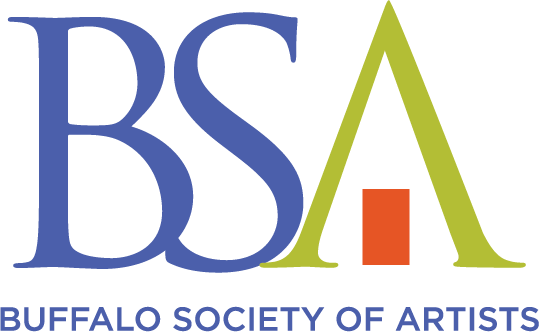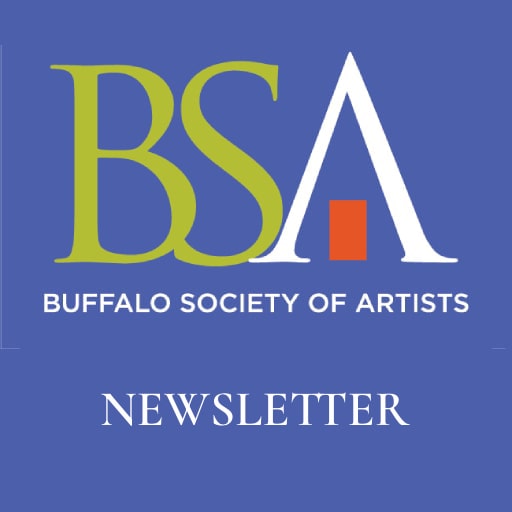
July 2010 BSA Newsletter (PDF)
This has been an interesting couple of years for the BSA. After a sort of soul-searching foray that we did with the strategic plan, we embarked on a bold course to more clearly define (and redefine) our organization, based on the stated wishes of the majority of our members. There was great wisdom in what you wanted: Better publicity; greater relevance to the community; more exhibitions; professional development. The Board with which I have been honored to serve has worked extremely hard to set these goals in motion, or, where they were already in motion, to make them work better. The changes, where made, weren’t entirely flawless or comfortable for everyone. Bugs had to be worked out, primarily with our website, the uploading of images for juried exhibitions and in the writing and revising of prospecti. We began ambitious undertakings: the massive redo of our website; the Video Archive Project; the Where Does The Art Go When the Artist Is Gone? seminar; the many programs at Artpark; the Studio Visits Program; and our dinner fundraisers. We are currently working on branding our organization and that requires that we establish a clear statement of mission.
Mission goes beyond purpose. Mission explains why we exist, and informs every decision we make; it also explains what makes us different from other regional arts organizations. At a meeting of our Communications Committee, guest Susan Shutte from Intellamarketing helped us to tighten our focus. Though we are a more traditional arts organization, not exactly on the cutting edge, Ms. Shutte asked, is that necessarily bad?
That got me to thinking. Moving toward one hundred and twenty years of existence, we are still standing, having seen many other visual arts groups come and go. Seventy five people have had my job, and are on the ongoing and ever-growing list of BSA presidents found at the back of every exhibition catalogue. Thousands of people have been members; thousands more applied to become members, some several times. Why is this so, if our harshest critics are right in suggesting that we’re too exclusive (no longer true, due to the change in the membership paradigm two years ago) and conservative?
Ms. Shutte posed another exercise by suggesting that we complete the sentence, “The BSA is the one arts organization which . . . .” Immediately several things came to mind:
1.) We are the only regional omnibus visual arts organization in Buffalo-Niagara region. Unlike Hallwalls, Buffalo Arts Studio, and the Western New York Artists Group, we take our art to the far corners of Erie and Niagara Counties since we do not have a specific home base. The Niagara Frontier Watercolor Society does this as well, but they focus, as their name implies, on one medium. The Fine Arts League of Buffalo also has traveling exhibitions, but they offer representational work only. These are not criticisms, just clarifications, by the way.
2.) We have offered professional development seminars, including educational programming, gallery talks, and studio visits. Other visual arts groups have also done this, but again, we have worked regionally.
3). We have the credibility of our history. We have, in our membership, long resumes in the profession of making, teaching, and marketing art. Any world-beaters in our ranks? We’ve had some, and there’s no telling who they are among our current members. When we approach the Castellani, the UB/Anderson, the Kenan Center, etc., if their schedule permits, they welcome our exhibitions because the BSA stands for quality and integrity in art. Too, we are running in the black, financially; we have superb talent on our Board and Committees helping to insure our future and realize our dreams. In the wings are potential visionaries and talents who I am confident will carry the torch.
As I approach the end of my second and final year as President of the BSA, I am at once pleased with what our Board has accomplished, while at the same time aware of our unfinished business. We are a work in progress; if we become overly satisfied with what we are, we will surely die from stagnation and irrelevance. How do we continue to carry the rich history and tradition of the BSA into the 21st century?
This my vision, my wish list, for the BSA in the coming years.
Imagine for a moment that we do find a home for our operations–a co-op gallery for tourists and art lovers to see (and buy) our work, and for us to conduct more seminars, classes, demonstrations, and workshops. A space would give us all the advantages of, for example, the Art Dialogue Gallery or Hallwalls, but wouldn’t keep us from continuing to take at least one major exhibition per year as well as many of our programs out to far corners of our region.
Imagine, too, incorporating into our website an art store, where potential buyers from all over the world could easily browse and purchase our work. We could present artists’ portfolios on a rotating basis, and have in place a system to facilitate purchases.
Imagine our Video Archive Project being available on our website–again perhaps on a rotating basis–to provide viewers with educational interviews that we have conducted with regional artists. We could also present videos of demonstrations, seminars, and gallery talks, to bring the cultural experience of our organization to the world.
Of course, much of this would require two major movers: money, and a membership willing to invest time to do the work needed to give us greater visibility and increase our relevance. To paraphrase Martin Luther King: I have seen the mountain. I saw it with the Tennessee Art League—how they started with a humble Cape Cod, which hosted many exhibitions, meetings, and workshops, then parlayed that into a million-dollar facility across the street from the Frist Center for the Visual Arts. It’s a tight community, a beehive of activity and commerce. It gets a lot of visitors and buyers. I know what the BSA has been, what it is, and what it can become. But it will take hard work to get there—that, and an undying commitment to something better for our organization.
My term will be over in November. Of my seven years in the BSA, I have spent just eight months as ‘just’ a member. I had times, as either an officer or Board member, when I just occupied a spot—because, after all, life does get in the way, doesn’t it? During this time, it has been my honor to serve with some outstanding people, some of whom came, shined for a while, then went back to their own careers, whatnot.
This having been said, I want to report that two shining stars—Lawrence Kinney and Helen Russell, have left the Board and are on to other artistic endeavors. I want to thank them here for their inestimable contributions over the past few years. Helen’s are well known to our membership; Larry will be remembered for having lit the fire for, and implementing, the Video Archive Project. When the latter comes to fruition, it will be noted that the first four artists video-archived will have been Larry’s work.
We are currently assessing possible replacements on our Board and have a couple of very promising candidates. Come November, a couple more terms will expire. We will need more people to step up to the plate. If you get a call, please consider running. It is a great bunch of people you will be working with.
And finally, one of our long-time Trustees, Mortimer Spiller, has stated his intention to retire after years of service to the BSA. I think I speak for everyone in our organization when I lament this. Mort, you are irreplaceable. We, the Board, invited him to stay on as Trustee Emeritus, and he had graciously agreed to do so. Thank you, Mort.





